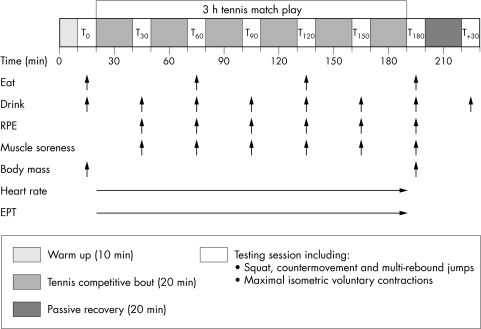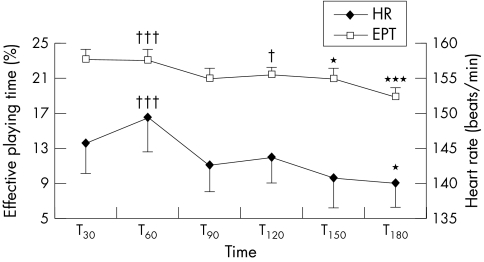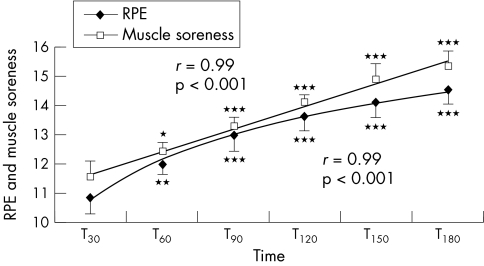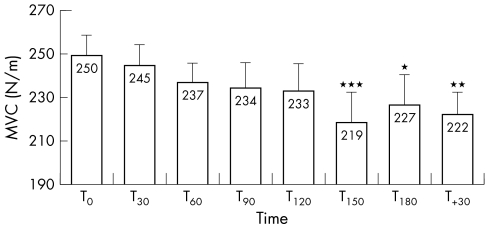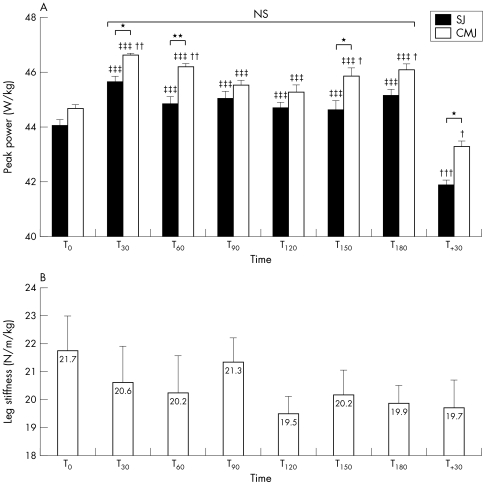Abstract
Objectives
To examine changes in exercise characteristics, maximal voluntary contraction, and explosive strength during prolonged tennis playing.
Methods
Maximal isometric voluntary contraction (MVC), leg stiffness (hopping), and peak power in squat (SJ) and countermovement (CMJ) jumps were measured before, every 30 minutes during, and 30 minutes after a three hour tennis match in 12 well trained players. Heart rate (HR), the effective playing time (EPT), rating of perceived exertion (RPE), and muscle soreness of knee extensors were also measured.
Results
Decreases in MVC (−9%; p<0.05) and leg stiffness (−9%; p = 0.17) were observed after the match and were significantly correlated (r = 0.66; p = 0.05). Peak power in SJ and CMJ tests was maintained during the match but was lower (p<0.001) 30 minutes after. Average HR and EPT were 144 (8) beats/min and 21 (4)% respectively. A strong correlation was found between EPT and HR (r = 0.93; p<0.05). RPE and muscle soreness increased linearly during the exercise and were significantly correlated (r = 0.99; p<0.001).
Conclusions
Progressive reductions in maximal voluntary strength and leg stiffness highly correlated with increases in perceived exertion and muscle soreness were observed throughout a three hour tennis match, whereas explosive strength was maintained and decreased only after the match. These alterations may result in less efficient on‐court movement and stroke production. They are, however, lower than those reported during continuous exercise of the same duration. The intermittent pattern of tennis and the numerous stretch‐shortening cycle movements partly explain these results.
Keywords: fatigue, intermittent exercise, leg stiffness, peak power, tennis
Elite tennis requires players to repeatedly generate power for explosive stroke production and rapid movement about the court during extended matches.1 As the duration of tennis matches is usually 90–120 minutes on grass and fast surfaces and 120–180 minutes (sometimes up to five hours) on clay,2 an important subject is the time course of changes in strength, power, and velocity during this prolonged intermittent exercise and the potential effects of fatigue on stroke production and the behaviour of the player. This explains the growing body of literature supporting observations by coaches that the onset of fatigue impairs tennis performance—that is, the time to complete shuttle runs and the accuracy and velocity of the serve and ground strokes.3,4
Functional impairments induced by prolonged continuous activity—for example, running, cycling, cross country skiing—have been well documented.5 However, less is known about changes in muscle function—that is, the ability to generate and maintain muscular strength and power—during prolonged, high intensity, intermittent exercise such as tennis, which consists of repeated bouts of brief (7–10 seconds), near maximal work interspersed with relatively short (<20 seconds) moderate/low intensity recovery periods.1 It is known that during multiple sprint work, such as in team and racquet sports, the magnitude of the progressive decline in power output is largely determined by the duration of the intervening recovery periods.6 One may therefore assume that, during a tennis match play, the exercise characteristics—that is, exercise intensity, temporal structure, effective playing time (EPT)—are related to the time course of impairment of muscle function (muscle strength and power). Studies on these factors are scarce and most have looked only at the difference between before and after.3,4
The aim of this experiment was therefore to examine changes in exercise characteristics and the time course of impairment of muscle function during prolonged tennis playing. We hypothesised that a three hour tennis match induces a progressive decrease in maximal voluntary contraction and explosive strength, which could be attributed to changes in exercise characteristics.
Methods
Subjects
Twelve well trained male tennis players (mean (SD) age 23.4 (1.6) years; height 178.5 (4.3) cm; body mass 72.2 (4.5) kg; body fat 14.1 (3.0)%) of regional to national level (international tennis ranking ranging from 2 to 4) volunteered to participate in this study after they were informed in detail about the nature of the experiment and possible risks. The subjects had done regular tennis training for at least 10 years, and their average weekly technical/tactical and physical training during the six months before testing were 4.9 (3.2) and 2.5 (1.4) hours a week respectively. Written informed consent was given by each subject, and the local committee on human research gave their approval for the project.
Experimental set up
A standardised warm up was carried out by each subject before the testing session. It consisted of five minutes of running at a self selected pace, followed by five minutes of tennis play. After this warm up protocol, peak power in squat jump (SJ) and countermovement jump (CMJ) tests was recorded. A multi‐rebound jump (MRJ) test was performed to evaluate leg stiffness (LS). Maximal isometric voluntary contraction (MVC) of the right knee extensor was also recorded. This test session was completed during brief interruptions before (T0), during (30, 60, 90, 120, 150, and 180 minutes: T30, T60, T90, T120, T150, and T180), and 30 minutes after (T+30) a three hour tennis match (fig 1). During the successive competitive tennis periods, heart rate (HR) was recorded continuously, and the temporal structure (rally and recovery durations, EPT) of each match was determined from video analysis. After each tennis period, rating of perceived exertion (RPE) and muscle soreness of the knee extensors were recorded using visual analogue scales. All experiments were performed on an outdoor Greenset tennis court area. The air temperature was 10–12°C. The independent variable was the time of measurement. Dependent variables were HR, EPT, RPE, muscle soreness, MVC, peak power, and LS.
Figure 1 Experimental set up. RPE, Rating of perceived exertion; EPT, effective playing time. Each test session was performed before (T0), during (T30: 30th min; T60: 60th min; T90: 90th min; T120: 120th min; T150: 150th min), immediately after (T180), and 30 minutes after (T+30) the three hour tennis playing exercise.
Three hour tennis match play
The prolonged exercise was a three hour standardised competitive tennis match. The scoring and time characteristics complied with the rules of the International Tennis Federation (2000). Therefore during the match, players were allowed to rest for a maximum of 20 seconds between rallies. However, the normal 90 second recovery period at the changeovers was not allowed. All subjects played against an opponent of similar standard. During the three hour match, subjects ingested 250 ml water every 30 minutes and a 77 kcal energetic biscuit after one and two hours of play. These drinking and eating regimens were intended to prevent dehydration and hypoglycaemia.
Exercise characteristics
HR was recorded continuously and averaged every five seconds during the match using short range radio telemetry (S610; Polar Electro Oy, Kempele, Finland). The temporal structure of tennis singles was determined by filming each match with a video camera (JVC, Ottawa, Ontario, Canada). From the tapes, a researcher timed the duration of each rally, which allowed the following mean variables to be calculated: (a) duration of rallies (DR, seconds); (b) total playing time (TPT, seconds); (c) real playing time (RPT, seconds) corresponding to the sum of DR; (d) EPT (ratio of RPT to TPT, %).
RPE and muscle soreness
Each participant was asked to indicate RPE according to the 6–20 Borg scale after each period of tennis. While squatting to a 90° knee angle with hands on hips, subjects also estimated muscle soreness of the knee extensors using a visual analogue scale. This scale was also numbered from 6 to 20, with 6 indicating no muscle soreness and 20 signifying that the muscles were too sore to move.
MVC
MVC of the right knee extensor muscles was measured on an isometric ergometer which consisted of a chair connected to a strain gauge (Captels, St Mathieu de Treviers, France). Subjects were placed in a seated position and securely strapped into the chair. Movements of the upper body were limited by two crossover shoulder harnesses and a belt across the abdomen. The trunk‐thigh angle was 90°. The axis of the dynamometer was aligned with the knee flexion‐extension axis, and the lever arm was attached to the shank with a strap. The knee angle was fixed at 80° of flexion (0° is the knee fully extended). The subjects were asked to perform two MVCs (five seconds duration), and the best result was recorded.
Vertical jumps
Jumps were performed in three ways: (a) from a static squatting position at 90° angle of the knee (SJ); (b) with a preliminary countermovement to 90° angle of the knee (CMJ); (c) one set of MRJs during 15 seconds with rebound to the highest possible point. For both SJs and CMJs, subjects were asked to perform two maximal trials, and the highest jump was recorded. During MRJs, subjects were instructed to keep their knees as stiff as possible (“ankle jumps”) and to have as brief a contact time as possible. They were asked to keep their hands on their hips to eliminate any influence of arm swing. Jump technique was demonstrated to each subject, followed by two submaximal attempts. Ground contact (MRJ) and flight times (SJ, CMJ, and MRJ) were recorded using optical measuring apparatus (Optojump; Microgate, Bolzano, Italy). From the flight times, the peak power (W/kg) in the SJ and CMJ tests was calculated.7 From the flight and contact times, LS (N/m/kg) in the MRJ test was approximated.8
Statistical analysis
Mean (SD) was calculated for all variables. A one way analysis of variance with repeated measures was used to calculate the statistical significance of differences between variables measured during competitive bouts (HR, EPT) and testing sessions (RPE, muscle soreness, MVC, peak power in SJ or CMJ as well as LS in MRJ). A two way repeated measures analysis of variance was used to examine the differences in peak power during SJ and CMJ over time. When appropriate, a Fisher's protected LSD post hoc test was used to determine pairwise differences between means. Spearman correlation coefficients were calculated to determine the relations between selected variables. Statistical significance was accepted at p<0.05. The statistical analyses were performed using SigmaStat 2.03 software (Jandel Corporation, San Rafael, CA, USA).
Results
After exercise, the body mass loss was 1.1 (0.7) kg, which was equivalent to 1.6 (1.0)% of body weight. During the three hour tennis match, the mean HR was 144 (8) beats/min. Mean DR and EPT were 7.0 (1.3) seconds and 21.3 (3.6)% respectively. Figure 2 presents changes in mean HR and EPT between each competitive bout of the prolonged exercise. There was a strong correlation (r = 0.93; p<0.05) between EPT and HR.
Figure 2 Heart rate (HR) and effective playing time (EPT) during each competitive tennis playing bout (T30: 30th min; T60: 60th min; T90: 90th min; T120: 120th min; T150: 150th min; T180: 180th min). Values are mean (SD) (n = 12). *p<0.05, ***p<0.001, Significantly different from T30. †p<0.05, †††p<0.001, Significantly different from T180.
As shown in fig 3, RPE and muscle soreness of knee extensors increased progressively (p<0.001) during the tennis match and were found to be highly correlated (r = 0.99; p<0.001).
Figure 3 Rating of perceived exertion (RPE) and muscle soreness of knee extensors during each competitive tennis playing bout (T30: 30th min; T60: 60th min; T90: 90th min; T120: 120th min; T150: 150th min; T180: 180th min). Values are mean (SD) (n = 12). *p<0.05, **p<0.01, ***p<0.001, Significantly different from T30.
Analysis of variance revealed a significant effect of exercise duration on MVC (p<0.01) but when compared with T0, the decrease in MVC reached significance only after 150 minutes (fig 4). Changes in RPE or muscle soreness during the match correlated inversely with change in MVC (r = −0.94; p<0.01) but not with change in LS (r = −0.66; p = 0.17). Decreases in MVC and LS during the course of the match were significantly correlated (r = 0.66, p = 0.05).
Figure 4 Maximal isometric voluntary contraction (MVC) of knee extensor muscles before (T0), during (T30: 30th min; T60: 60th min; T90: 90th min; T120: 120th min; T150: 150th min), immediately after (T180), and 30 minutes after (T+30) the three hour tennis playing exercise. Values are mean (SD) (n = 12). *p<0.05, **p<0.01, ***p<0.001, Significantly different from T0.
Mean peak power in SJ was significantly (p = 0.017) lower than in CMJ (44.4 v 45.4 W/kg for SJ and CMJ respectively) (fig 5A). Changes in peak power in the SJ and CMJ tests over time correlated strongly (r = 0.95; p<0.001). LS decreased slightly during the course of the exercise (−9% at T180) but the decrease was not significant (fig 5B).
Figure 5 Peak power during squat (SJ) and countermovement (CMJ) jumps (A) and leg stiffness during multi‐rebound jumps (B) before (T0), during (T30: 30th min; T60: 60th min; T90: 90th min; T120: 120th min; T150: 150th min), immediately after (T180), and 30 minutes after (T+30) the three hour tennis playing exercise. Values are mean (SD) (n = 12). *p<0.05; **p<0.01, Significant difference between SJ and CMJ. †p<0.05, ††p<0.01, †††p<0.001, Significantly different from T0. ‡‡‡p<0.001, Significantly different from T+30.
Discussion
To the best of our knowledge, this study is the first to describe changes in exercise characteristics and decreases in isometric strength, explosive power, and leg stiffness related to progressive increases in perceived exertion and muscle soreness, during prolonged on‐court competitive tennis. These findings may help to explain the commonly observed changes in on‐court movement and stroke production during fatigue.
The temporal characteristics (DR ∼7 seconds; EPT ∼21%) and mean intensity (HR ∼144 beats/min) found here are in line with previous studies (DR 7–10 seconds; EPT 20–30%; HR 140–160 beats/min) performed on the same playing surface and highlight the intermittent nature of the exercise performed.1,9 One interesting finding is the relation between EPT and HR, showing that the exercise characteristics of tennis strongly influence the energy requirements. Smekal et al10 have reported that the duration of rallies and EPT are the most significant factors of energy expenditure in tennis. However, as the playing pattern is not predictable and is influenced by various additional factors, such as the style of play, the playing surface, and the standard of the opponent, energy demands may vary greatly.1,9,10
To our knowledge, changes in RPE during the course of a tennis match have never been investigated, although previous studies have used visual analogue scales (1–10 scale).11,12 Despite the fact that HR was decreased near the end of the match, RPE and muscle soreness gradually increased throughout. This dissociation between work rate and RPE during the course of a prolonged tennis match indicates that other factors unrelated to cardiovascular stress probably determine RPE in this type of intermittent activity, in particular mechanical factors, as evidenced by the relations between RPE and MVC or LS. Exercise induced muscle damage is a well documented phenomenon in activities with a high eccentric component.5 Considering that strenuous eccentric contractions—that is, breaking, flexion, stretch‐shortening actions—occur frequently in tennis during serving, intense shuttle runs, and powerful stroke production,13,14 one might assume that exercise induced muscle damage is likely to occur during prolonged tennis matches and therefore explain the expected alteration in muscle function. This is supported by the present relations between perceived muscle soreness of knee extensors, which regularly increased during the match, and decreases in both MVC and LS.
Although the ability of muscle to generate explosive strength—that is, peak power in the SJ and CMJ tests in this study—is commonly considered to be functionally more pertinent to athletic performance than measures of muscle strength,15 isokinetic muscle strength has been shown to effectively predict ball velocity.16 This suggests that measuring maximal strength (MVC) may be a relevant test when evaluating tennis players. Interestingly, MVC decreased progressively during the match, and this decrease reached significance after two and a half hours (−12% at T150 and −9% at T180). As this study is the first to report changes in MVC during tennis singles play (or any intermittent prolonged exercise), comparison with the literature is not possible. However, not surprisingly, the decrease in MVC is lower than in prolonged continuous exercise such as running, cycling, and cross country skiing (−19–35%).5 The parallel decline in MVC and LS (r = 0.66; p = 0.05) confirms that the ability to maintain the force generating capacity during prolonged exercise is influenced by regulation of leg stiffness. It has been shown that impairment of stretch‐shortening cycle performance is associated with a lowered tolerance to ground impact and reduced joint stiffness.17 However, further experiments on neuromuscular fatigue induced by prolonged tennis playing are needed to shed light on the origins (central and/or peripheral) of the observed decrease in muscular strength.
During the first 30 minutes of exercise, improvement in CMJ and SJ height may be attributable to an increase in muscle temperature through mechanisms such as increased transmission rate of nerve impulses, decreased viscous resistance, and/or increased glycogenolysis, glycolysis, and high energy phosphate degradation.18 This result suggests that the warm up was not sufficient. However, the most interesting finding is that the three hour tennis match did not alter explosive strength. This can probably be explained by the numerous recovery periods between points (∼79% of the total duration of the match), which may be sufficient for replenishment of ATP and phosphocreatine.6 During high intensity, intermittent exercise, recovery periods play an important role in limiting fatigue.19 There is evidence to suggest that the provision of fluids and carbohydrate during intermittent exercise may improve physiological and mental performance and also help to delay fatigue caused by dehydration.20 Thus, although a 1.6% decrease in body mass was observed, the regular ingestion of carbohydrates and electrolytes was probably sufficient to maintain the explosive qualities, as carbohydrate intake has been found to improve explosive strength (Sargent jump) after two hours of tennis.21
Also of interest is the delayed alteration in explosive strength in both the SJ and CMJ tests after the 30 minute passive recovery period. It has been shown that stretch‐reflex sensitivity is reduced after exhausting stretch‐shortening cycle exercise.22 Although the exact mechanisms of this inhibition remain unclear, it has been emphasised that the delayed recovery of reflex sensitivity may result from the progressive inflammation that develops in cases of muscle damage.23 In the present experiment, however, if inhibition of the stretch reflex had occurred during the course of the match, a greater decrease in CMJ height than SJ height would have been observed over time, as the activation of the muscle spindle during stretching increases the height of the CMJ.24 Interestingly, changes in explosive strength over time in this study were similar (fig 5A), as evidenced by the strong correlation between peak power in the SJ and CMJ tests at the different testing times. This does not agree with the findings of Hortobagyi et al25 that SJ performance decreased to a greater extent than CMJ performance in damaging exercise.
The ability to produce and maintain a high level of stiffness has been considered an important factor of explosive exercise, particularly for sprint running and hopping.26 The present mean LS value in the non‐fatigued state (21.7 N/m/kg) is in line with the range reported previously (21.8–27.5 N/m/kg).13 Even if alterations in the series elastic component cannot be ruled out, the progressive decrease in LS during the three hour exercise was probably due mainly to neuromuscular activation failure. Although the difference in LS values before and after exercise did not reach significance, the factors responsible for such neuromuscular alterations may be related to a decreased central drive, disfacilitation of the stretch reflex, and/or inhibition of activation through type III and IV afferent fibres, which are sensitive to inflammation.27 This decreased LS is in line with a previous experiment showing that exercise including stretch‐shortening cycle contraction can result in reduced tolerance to stretch load.28
Although the standard muscle strength (MVC) and power (vertical jumping) tests used in this study may be valid for general assessments of neuromuscular function, their external validity in terms of their relations to performance in various functional movements tests such as serving and ground strokes in tennis has been shown to be moderate, if not insignificant.29 In addition, it is unclear if vertical jump performance reflects lower limb activity during tennis stroke production.
What is already known on this topic
Functional impairment induced by prolonged continuous activity is well documented, but less is known about changes in muscle function during prolonged, high intensity, intermittent exercise such as tennis
Although previous work has suggested that muscular fatigue impairs tennis performance, it is not known if changes in match characteristics during prolonged tennis play are related to the time course of impairment of muscular strength and power
What this study adds
Progressive reductions in maximal isometric voluntary strength and leg stiffness closely correlated with increases in perceived exertion and muscle soreness were observed throughout a three hour tennis match, whereas explosive strength was maintained and decreased only after the match
The intermittent pattern of tennis and the numerous stretch‐shortening cycle movements may help to explain the commonly observed changes in on‐court movement and stroke production during fatigue
A knowledge of the time course of changes in explosive power in response to prolonged tennis playing is essential for the supervision of training. Coaches may plan training sessions aiming to develop in parallel the phosphocreatine energy system and aerobic power to improve the ability to repeat powerful actions and recover more effectively. It seems that an efficient method is to add pliometric, velocity, and/or intermittent running exercises to the traditional tennis‐only training programmes.1,9,30 Another issue is how to structure training and competition programmes to accommodate exposure to exercise induced muscle damage.
Conclusion
Progressive reductions in MVC and leg stiffness closely correlated with increases in perceived exertion and muscle soreness were observed throughout a three hour tennis match, whereas explosive strength was maintained and decreased only after the match. The intermittent pattern of tennis and the numerous stretch‐shortening cycle movements partly explain these results. Taken together, these findings may help to explain the commonly observed alterations in on‐court movement and stroke production during fatigue.
Abbreviations
CMJ - countermovement jump
EPT - effective playing time
HR - heart rate
LS - leg stiffness
MRJ - multi‐rebound jump
MVC - maximal isometric voluntary contraction
RPE - rating of perceived exertion
SJ - squat jump
Footnotes
Competing interests: none declared
References
- 1.Lees A. Science and the major racket sports: a review. J Sports Sci 200321707–732. [DOI] [PubMed] [Google Scholar]
- 2.O'donoghue P G, Liddle S D. A notational analysis of time factors of elite men's and ladies' singles tennis on clay and grass surfaces. J Sports Sci 199816592–593. [Google Scholar]
- 3.Mitchell J B, Cole K J, Grandjean P W.et al The effect of a carbohydrate beverage on tennis performance and fluid balance during prolonged tennis play. Journal of Applied Sport Science Research 19926174–180. [Google Scholar]
- 4.Vergauwen L, Brouns F, Hespel P. Carbohydrate supplementation improves stroke performance in tennis. Med Sci Sports Exerc 1998301289–1295. [DOI] [PubMed] [Google Scholar]
- 5.Millet G Y, Lepers R. Alterations of neuromuscular function after prolonged running, cycling and skiing exercises. Sports Med 200434105–116. [DOI] [PubMed] [Google Scholar]
- 6.Glaister M. Multiple sprint work: physiological responses, mechanisms of fatigue and the influence of aerobic fitness. Sports Med 200535757–777. [DOI] [PubMed] [Google Scholar]
- 7.Harman E A, Rosenstein P N, Frykman R M.et al Estimation of human power output from vertical jump. Journal of Applied Sport Science Research 19915116–120. [Google Scholar]
- 8.Dalleau G, Belli A, Viale F.et al A simple method for field measurements of leg stiffness in hopping. Int J Sports Med 200425170–176. [DOI] [PubMed] [Google Scholar]
- 9.König D, Huonker M, Schmid A.et al Cardiovascular, metabolic, and hormonal parameters in professional tennis players. Med Sci Sports Exerc 200133654–658. [DOI] [PubMed] [Google Scholar]
- 10.Smekal G, Von Duvillard S P, Rihacek C.et al A physiological profile of tennis match play. Med Sci Sports Exerc 200133999–1005. [DOI] [PubMed] [Google Scholar]
- 11.Kraemer W J, Piorkowski P A, Bush J A.et al The effects of NCAA division 1 intercollegiate competitive tennis match play on recovery of physical performance in women. J Strength Cond Res 200014265–272. [Google Scholar]
- 12.Novas A M, Rowbottom D G, Jenkins D G. A practical method of estimating energy expenditure during tennis play. J Sci Med Sport 2003640–50. [DOI] [PubMed] [Google Scholar]
- 13.Girard O, Micallef J P, Millet G P. Lower‐limb activity during the power serve in tennis: effects of performance level. Med Sci Sports Exerc 2005371021–1029. [PubMed] [Google Scholar]
- 14.Roetert P, Groppel J L. Mastering the kinetic chain. World class tennis technique. Champaign, IL: Human kinetics publishers, 200261–83.
- 15.Clarkson P M, Newman D J. Associations between muscle soreness, damage and fatigue. In: Gandevia SC, Enoka , RM , MacManus AJ, eds. Fatigue: neural and muscular mechanisms. New York: Plenum press, 1995457–469. [DOI] [PubMed]
- 16.Signorile J F, Sandler D J, Smith W N.et al Correlation analyses and regression modeling between isokinetic testing and on‐court performance in competitive adolescent tennis players. J Strength Cond Res 200519519–526. [DOI] [PubMed] [Google Scholar]
- 17.Clarkson P M, Sayers S P. Etiology of exercise‐induced muscle damage. Can J Appl Physiol 199924234–248. [DOI] [PubMed] [Google Scholar]
- 18.Bishop D. Warm up. II. Performance changes following active warm up and how to structure the warm up. Sports Med 200333483–498. [DOI] [PubMed] [Google Scholar]
- 19.Ratel S, Lazaar N, Williams C A.et al Age differences in human skeletal muscle fatigue during high‐intensity intermittent exercise. Acta Paediatr 2003921248–1254. [PubMed] [Google Scholar]
- 20.Welsh R S, Davis J M, Burke J R.et al Carbohydrates and physical/mental performance during intermittent exercise to fatigue. Med Sci Sports Exerc 200234723–731. [DOI] [PubMed] [Google Scholar]
- 21.Burke E R, Ekblom B. Influence of fluid ingestion and dehydration on precision and endurance performance in tennis. In: Suckers R, ed. Current topics in sports medicine. Vienna: Urban & Schwarzenberg, 1984379–388.
- 22.Horita T, Komi P V, Nicol C.et al Stretch shortening cycle fatigue: interactions among joint stiffness, reflex, and muscle mechanical performance in the drop jump [corrected]. Eur J Appl Physiol Occup Physiol 199673393–403. [DOI] [PubMed] [Google Scholar]
- 23.Byrne C, Twist C, Eston R. Neuromuscular function after exercise‐induced muscle damage: theoretical and applied implications. Sports Med 20043449–69. [DOI] [PubMed] [Google Scholar]
- 24.Bosco C, Ito A, Komi P V.et al Neuromuscular function and mechanical efficiency of human leg extensor muscles during jumping exercises. Acta Physiol Scand 1982114543–550. [DOI] [PubMed] [Google Scholar]
- 25.Hortobagyi T, Lambert N J, Kroll W P. Voluntary and reflex responses to fatigue with stretch‐shortening exercise. Can J Sport Sci 199116142–150. [PubMed] [Google Scholar]
- 26.Chelly S M, Denis C. Leg power and hopping stiffness: relationship with sprint running performance. Med Sci Sports Exerc 200133326–333. [DOI] [PubMed] [Google Scholar]
- 27.Avela J, Kyrolainen H, Komi P V.et al Reduced reflex sensitivity persists several days after long‐lasting stretch‐shortening cycle exercise. J Appl Physiol 1999861292–1300. [DOI] [PubMed] [Google Scholar]
- 28.Avela J, Komi P V. Reduced stretch reflex sensitivity and muscle stiffness after long‐lasting stretch‐shortening cycle exercise in humans. Eur J Appl Physiol Occup Physiol 199878403–410. [DOI] [PubMed] [Google Scholar]
- 29.Wilson G J, Murphy A J. The use of isometric tests of muscular function in athletic assessment. Sports Med 19962219–37. [DOI] [PubMed] [Google Scholar]
- 30.Kraemer W J, Mazzetti S A, Nindl B C.et al Effect of resistance training on women's strength/power and occupational performances. Med Sci Sports Exerc 2001331011–1025. [DOI] [PubMed] [Google Scholar]



